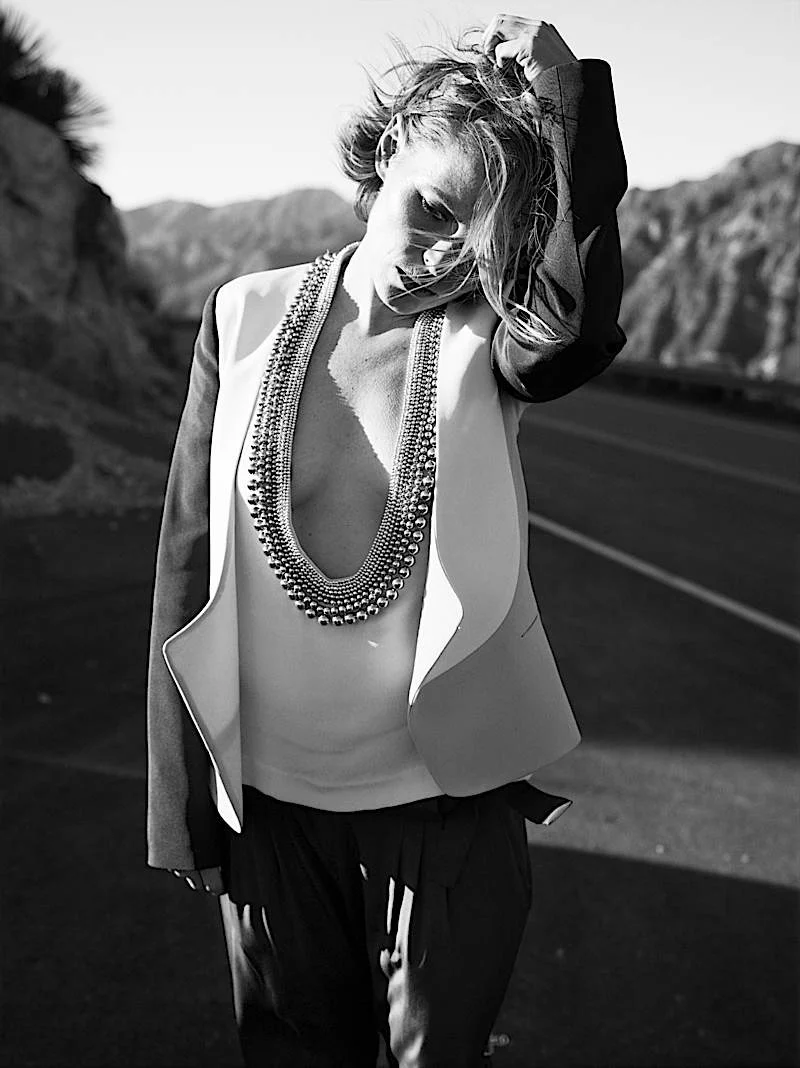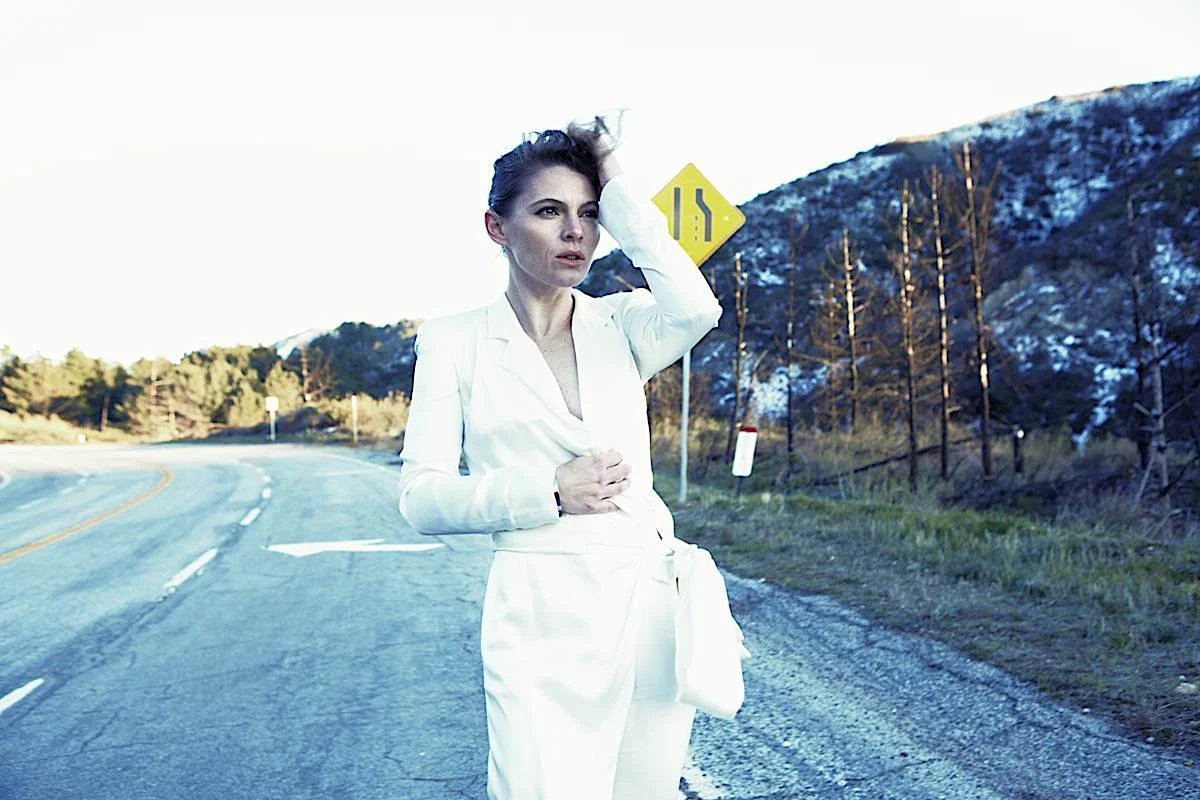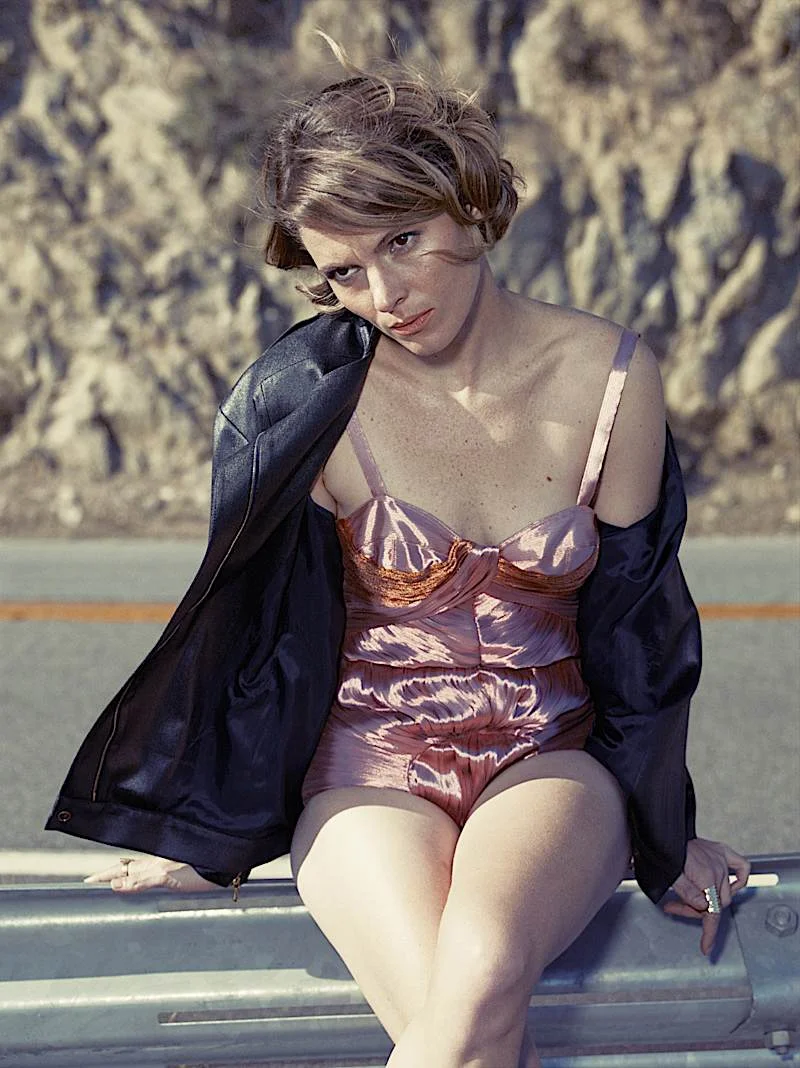
Denim jacket by **Levi’s,** Bonded Matelassé jacquard sleeveless flirt dress with embroidered neckline by **3.1 Phillip Lim,** and Patent Leather Slip On Heels by **Stuart Weitzman.**

Crepe Jacket, Blouse, and Pants by **Diane Von Furstenberg**.

Silk Dress and snakeskin heels by **Viktor & Rolf** and Silver bracelet with wooden creature and red stone by **Marni**

Mink Fur Blouson and Denim Pencil Skirt by **Miu Miu.**

Jacket by **Zimmermann**, Degradé Metallic Lurex Plisse Swimsuit by **Burberry Prorsum**, and Candace Brass ring with 18K Gold by **BesoBeso by LUKA.**
[](#)[](#)
Amy Seimetz: The Indie World Triple Threat Defies Expectations
Well Isn't This a Good Place to Bury the Dead?
Indie has become a diluted word. Like organic, or local, or any other buzzword that appeals to coastal twenty- and thirty-somethings with mustaches and penchants for mason jars, it’s a sexy, enticing, but ultimately empty adjective that lost meaning the moment eager branders co-opted it.
Amy Seimetz, dubbed “the darling of the indie world” by many a Sundance-seduced critic, rejects it. (She rejects “darling” too. “They never say that about men.”) You see, when indie has evolved to mean something stylistic—something, say, stripped down or true-to-life—the end result is that films with budgets of hundreds of thousands get pooled with those whose budgets are much meeker, and no one is the wiser because both still fall into the original definition of independent; i.e. a film produced without funding by a major film studio. It’s not really honest “or even the same system” Seimetz says.
Despite eschewing the term, the actress/writer/director has rather dominated the world of independent cinema—and I use that word in its prototypical sense—and she’s becoming a household name.
She associate produced Barry Jenkins' _Medicine For Melancholy_ (2008) which was nominated for Gotham and Independent Spirit Awards; became known as an actress in Joe Swanberg's _Alexander The Last_ in 2009; then continued a winning run of solid indie performances in 2010 with Lawrence Levine's _Gabi On The Roof In July_, Lena Dunham's _Tiny Furniture_ , and Kentucker Audley's _Open Five_. By 2011, her performance in Megan Griffiths drama _The Off Hours,_ which premiered at the Sundance film festival in 2011, had the _Los Angeles Times_ calling her the "MVP of Sundance.” By 2013, she was back at Sundance again, starring in Shane Carruth’s _Upstream Color_ and Yen Tan’s _Pit Stop._
A decade-long veteran of the film world, she’s now learning as her fame grows that people love an up-and-comer. So much so that they want her ingratiation with the film world to be brand-spanking-new, a kind of Diablo Cody, prostitute-cum-prolific-writer type of story, the narrative film version of the dorky girl who removes her glasses to learn she’s a smoking hot babe.
“People want me to be some sort of wide-eyed ingénue. I’ve been doing this for ten, thirteen years; it’s a little hard to be wide-eyed,” she says via Skype from Vancouver, B.C., where she’s staying for the next several months to act in the AMC series _The Killing._
Though her upcoming film, _Sun Don’t Shine_, will be her narrative debut, she’s been involved in film in just about every other creative facet, from writing and directing shorts to acting in television shows. The idea that she’s new is, at best, laughable and. at worst, undermining. “Even when I’m an asshole in interviews, when articles get written, exclamation points are added on and it’s like I’m all wide-eyed. I mean, I work really fucking hard,” she says, squeezing her eyes shut and clenching a fish as if to demonstrate the effort.
Noted. Truth be told, in transcribing our interview, I had punctuated that exact statement with an exclamation point (because it was emphatic!) omitting it only after the fact. She’s no asshole, even as her voice gets an edge to it when I use the word “darling.” She is intellectual and contemplative and articulate, so it’s easy to see how a slew of _Stepford Wives_\-esque punctuations is a war, albeit a small one, that she’s fighting.
Expectations of women are one of several themes running through _Sun Don’t Shine_, a film Seimetz says is, in a phrase, “really just two lovers burying a body.” When boiled down to a single sentence, the plotline sounds like an archetypal thriller. But, like the heavy Florida air that soaks the skin of her lead characters as they fly down dusty highways in sun-bleached shirts, the simple concept blankets lurid realities. “There are a lot of themes in there that I wanted to explore. That’s why I did that very simple through-line of having them have an end goal, which is to bury the body, and being able to run off on other themes while I executed that one goal.” Chief among those themes is what it means to be a “good women,” a task her lead female decidedly fails.
The characters—Crystal, a tantrum-prone, emotionally erratic female who killed her husband and Lee, Crystal’s focused-to-a fault sidekick (and lover) who’s helping her bury the body—are “a giant metaphor for burying secrets and not talking about them, not talking about what’s actually going on, while you’re continuing to live.” Each pulls a different direction, heightening the problematic nature of either extreme response to trauma. “What I wanted to do with these two characters is, in the face of death, have the one response, which is wanting to just kick and scream and punch walls and be kind of an emotional mess. Because I think a lot of times, in traumatic situations, you revert into almost a tantrum, childlike state, but obviously you can’t be doing that all the time. But that kind of exists in response to that situation. And the other side of a response to trauma, or to death, is to want to have a methodical plan for it, or to do it nuts and bolts, and lay it out with a plan.”
The tension between the disparate attempts to make the gory predicament copacetic carries the majority of the plotline, and in that sense, Seimetz says, _Sun Don’t Shine_ is really about a relationship. Couched in the turquoise-and-pink infused backdrop of humid Florida back roads is a story of two people trying to push through a difficult situation.
_Sun Don’t Shine_ is categorically conflicted—it’s been called a horror film, a thriller, a genre bender, and Seimetz says all are accurate, if you cherry pick components from each. “I think I was playing around with genre elements, like horror and thriller and noir and the road movie, but I wanted to blend all of those elements together, as opposed to making something purely horror or purely noir. I wanted to make a movie that encapsulated all of those genres, all of my favorite parts of those genres.”
It’s that same approach to her career that’s situated Seimetz in a unique position to take it any direction she likes, having gleaned experience both in front of the camera and behind it. “I think the lid’s been blown off the system at this point, in how people are making movies and what’s selling. No one really knows right now. So it sort of opens up the door for so many people that walk in—for marginalized groups to walk in, whether it’s women or African Americans, or certain types of comedy, or certain types of strange, obscure films. So more stories are coming out…But I think, also, I think women are tired of seeing movies where they don’t have their own existential crisis going on, they have to be a part of someone else’s existential crisis…I think I’m so fiery about that topic, no one’s going to try anything.”
